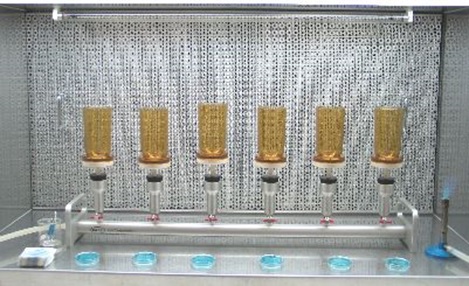What is a sterility check?
A sterility check during wine packaging is a microbiological analysis performed to check for viable microorganisms growing on sanitised equipment or within packaged wine. Its purpose is to confirm that any antimicrobial steps performed during the packaging process have been successful. Such steps may include the use of chemical preservatives (e.g. sulfur dioxide in conjunction with pH, sorbic acid and dimethyl dicarbonate) or physical operations such as sanitation of line equipment and filtration of wine. Tips are available on avoiding microbial spoilage in wine along with a wide range of laboratory methods for microbiological analysis.
Why is microbiological stability important?
Undesirable microorganisms growing in packaged wine can shorten shelf life and cause wine hazes, spritz or off-flavours. Post-packaging microbiological spoilage is most commonly caused by Saccharomyces cerevisiae yeast, the primary yeast used to perform alcoholic fermentations. Acetic acid bacteria and lactic acid bacteria are the most common bacteria responsible for spoilage in packaged wine. Mould generally is not able to grow in an oxygen-free alcoholic wine environment but can grow on equipment surfaces.
When is a sterility check conducted?
Sterility checks can be performed on the final wine blend in tank, on the wine post-filtration, at set intervals throughout a packaging run (start, middle and end of the bottling run, or for some companies as hourly checks) as well as immediately post-packaging. The number of samples analysed will be dictated by the volume of wine or length of time of a bottling run. Microbiological tests are typically performed at bigger wineries and/or packaging facilities who are set up to do in-house microbiological testing. If a winery conducts bottling by hand, or using on-site mobile bottling operations, then it is common for only a final packaged wine to be tested, using a contract laboratory.
How do you perform a sterility check?
This viable plating method details how to perform a sterility check if a microbiology laboratory is available. Filtration of wine onto microbiological plates needs to be performed using aseptic technique in a laminar flow cabinet to prevent contamination from other microorganisms in the environment. Wineries often conduct several filtrations at once using a filtration manifold, shown in the picture below.

An example of a manifold set-up in a laminar flow cabinet used when performing sterility checks
During a sterility check, a certain volume (typically 100 mL) of wine is filtered through each of several 0.45 µm membrane filters, which are then incubated for 10 days on WL media to detect any yeast growth and MRS/A/C growth media plates to detect any bacteria. Visual examination and enumeration of any microbiological colonies growing on the plates is conducted at three, seven and ten days. Any colonies are then examined using microscopic techniques. Identifying yeast and bacteria under the microscope can be difficult. Pictures of commonly isolated microorganisms from wine can be used as a guide. More advanced and rapid microbiological techniques for testing wine and bottles during packaging are emerging, but currently are not widely used in the wine sector.
Affinity Labs also provides microbiological services to wineries that do not conduct their own microbiological testing.
Unfiltered or minimal filtration wines
Of course, not all wines require sterile filtration and not all winemakers choose to fine or to tightly filter certain wines; however, this course of action comes with some associated risks. For example, some export destinations enforce maximum turbidity levels (in NTU). If minimal or no filtration is to be employed, wine producers are advised to check the analytical requirements for any countries to which the wine will be exported.
Interpretation of results
There are currently no agreed specifications or legal requirements for the presence of yeast and/or bacteria in wine post-bottling. Often results are recorded as either a pass or a fail. If the wine fails, information will typically be provided that includes the number of colonies present for the volume of wine filtered, and a description of the cells viewed under the microscope. For example, a wine might be reported as having 25 colony forming units (cfu)/100 mL, consisting of ovoid shaped yeast cells, approximately 5-7.5 µm in size.
Tolerances for acceptable levels of yeast and bacteria will vary depending on the wine style and the type of filtration used at bottling. Typically they are lower for yeast than bacteria. For example, a dry white wine might have a low-level tolerance for the presence of yeast such as 1 cfu/750mL, while a semi-sweet wine containing residual sugar should have zero tolerance for the presence of any yeast.
A table is provided below to help with interpretation. This guide has been developed from a combination of anecdotal evidence from winemakers, microbiologists and bottling facilities, as well as the knowledge gained from numerous AWRI audits conducted on wine bottling facilities across Australia. It should be noted that many wineries have zero tolerance for yeast.
| G+F 0-3 g/L | G+F >3 g/L | |
| Number of colonies | 1-3 cfu/750 mL | 0 cfu/750 mL |
| G+F 0-3 g/L | G+F >3 g/L | |
| Number of colonies | 9-10 cfu/750 mL | 0 cfu/750 mL |
Note: For bacteria and mould, the tolerances are higher, and are typically in the range of 9-10 cfu/750 mL bottle for dry styles. Results are typically reported in colony forming units per mL, or cfu/mL or cfu/100 mL or cfu/750 mL.
What to do if the sterility check fails?
If a sterility check fails, then standard protocol would be to first place the product from that packaging run on hold and repeat the sterility check. If the wine still fails the repeat check, then it is recommended that the product remains on hold and further sterility checks are conducted over a short period of time looking for a decline in cfu/750mL. If this does not occur, it is recommended to contact the AWRI helpdesk helpdesk@awri.com.au for advice on what to do next.

